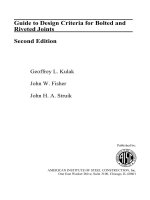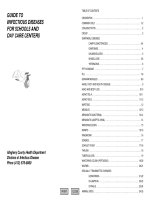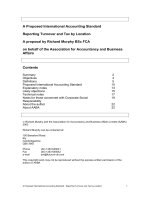The financial planning workbook managing to be wealthy for individuals and business owners
Bạn đang xem bản rút gọn của tài liệu. Xem và tải ngay bản đầy đủ của tài liệu tại đây (651.05 KB, 90 trang )
Copyright © 2016 Coventry House Publishing
All rights reserved.
The author and publisher have provided this e-book to you without Digital Rights Management
software (DRM) applied so that you can enjoy reading it on your personal devices. This e-book is for
personal use only and may not be printed, posted, or reproduced.
Contents
Chapter 1: Preparing Your Financial Plan
Chapter 2: Income Planning
Chapter 3: Discover Your Net Worth
Chapter 4: Investments
Chapter 5: Retirement Planning
Chapter 6: Insurance
Chapter 7: Dependent Planning
Chapter 8: Estate Planning
Epilogue: Your Next Steps
About John E. Sestina and Company
1
Preparing Your Financial Plan
Welcome to The Financial Planning Workbook. Our goal is to help you build or repair your
financial plan using the proven methods and exercises outlined in the following chapters. Inside this
book you will be introduced to the practice of personal financial planning and you will learn how to
create and monitor a successful financial plan. But before you can begin your path to financial
independence, you first need to identify your starting point. By recognizing where you are today,
you’ll be able to set tangible goals and track your success from this point forward.
Exercise 1.1: Identifying Your Habits
For this exercise, indicate which of the following statements apply to you. The chapters that
follow will help you break these poor financial habits and replace them with responsible alternatives.
• I routinely carry a balance on my credit cards that I’m unable to pay in full each month.
• At least one of my credit cards is currently maxed out.
• I’ve had to borrow money from family or friends to pay my bills within the last year.
• I do not have any money saved for emergencies.
• I don’t bother balancing my checkbook or reconciling my bank statements at the end of each month.
• I’m not sure whether my employer offers a retirement plan or a company match.
• I’m not sure how much I’m currently saving towards retirement.
• I haven’t reviewed my investments within the last year.
• I don’t have a will, living will, financial power of attorney, or healthcare power of attorney.
• I haven’t given serious thought to when I’d like to retire or how much I plan to spend during
retirement.
• I’m not sure what would happen if I became disabled and couldn't pay my bills.
• I’m not sure if my family would be financially stable if I were to die.
Exercise 1.2: Evaluating Your Current Financial Plan
Now that you’ve identified the parts of your financial plan that may be failing you, it’s time to
assess your strengths. Indicate whether the following statements are satisfactory or need
improvement.
• My ability to set realistic and attainable financial goals
• My ability to create and maintain a budget
• My ability to save money
• My credit score
• My understanding of the investments I have and their associated risks
• My current level of retirement savings
• Life and disability insurance premiums, deductibles, and coverage amounts
• Home, auto, and umbrella insurance premiums, deductibles, and coverage amounts
• My overall estate plan
Exercise 1.3: How Well Do You Know Your Financial Situation?
Maybe you’ve identified a few bad habits that you’d like to break and you realize that a fair
amount of your financial plan needs improvement. It’s unlikely that you’ve intentionally made poor
financial decisions that led you to this point; it’s much more likely your financial plan has been failing
you because you simply aren’t aware of the many intricate details involved. To explore this
possibility, indicate which of the following statements are true regarding your present financial
situation.
• I know how much I earn and how much I spend each month, and what my savings surplus or deficit
is.
• I know the value of my assets, liabilities, and net worth within a few thousand dollars.
• I have recently reviewed the various lines of insurance that I have and discussed their adequacy
with my insurance agent.
• I have recently reviewed the various lines of insurance that I have and discussed their adequacy
with my insurance agent.
• I have met with my accountant to discuss tax planning strategies within the last year.
• I understand the basic characteristics of the various investments that I own and they match my
tolerance for risk.
• I know how each of my investments has performed over the last year.
• I know the fees associated with each of my investments.
• I know the current balance of my investment accounts within a few thousand dollars.
• I participate in my employer’s retirement plan and take advantage of the company match.
• I make the maximum contribution to my IRA each year.
• I have reviewed my credit report and checked my credit score within the last year.
• I know how much state and federal estate tax would be payable if I were to die this year.
• I have recently reviewed my estate plan with an attorney.
Now that you have a strong understanding of your overall strengths and weaknesses, write down
three aspects of your financial plan that you’d like to improve over the next year.
If you were to improve the three aspects that you wrote down, how would it make you feel? One
year from now, if you were on track to meet your retirement goal, had the proper lines of insurance in
place to protect your family, and were on the path to becoming debt free, what would that mean to you
and your family?
As we turn our focus to building your financial plan, you first need to understand what financial
planning is, and what obstacles you’ll encounter during this process.
What is Financial Planning?
• Organizing
• Analyzing
• Setting goals
• Planning
• Implementing
• Reviewing
What are the Obstacles?
• Inflation
• Taxation
• Death
• Disability
• Ego
• Lack of a plan
Above all else, financial planning is a complete process. If you were to organize your data,
analyze it, and set goals for yourself, your plan will assuredly fail if you do not implement the
strategies presented and regularly review their progress. For this reason, we recommend that you
focus on the following topics each quarter to ensure that you do not neglect any facet of your financial
plan.
• First quarter: Data gathering, goal setting, tax planning, retirement
• Second quarter: Dependents, education planning, investments, risk analysis
• Third quarter: Life insurance, disability insurance, long-term care planning, estate planning
• Fourth quarter: Year-end tax planning, home and auto insurance, direct investments, business
interests
Exercise 1.4: What Are You Afraid Of?
Each chapter of this workbook will guide you through the different quarterly focus items outlined
in the previous chart. You’ll learn that each topic carries its own set of obstacles and challenges that
you’ll need to overcome. In this exercise you’ll begin to learn what those challenges will be by
identifying what you’re afraid of when it comes to your financial future. Indicate which of the
following items concern you.
• Low investment returns
• Losing my job
• Another “Great Recession”
• Inflation
• Rising taxes
• Social Security cuts
• Rising medical costs
• Outliving my money
Exercise 1.5: Gathering Data
You’ll be asked to call upon the following information as you build your financial plan. For each
document listed in the chart that follows, make sure that you’re safely storing it using the guidelines
provided.
Keep these documents in your
safe deposit box
Birth certificates
Citizenship papers
Deeds
Inventory of personal property
Leases
Loans
Marriage and divorce records
Military service records
Store documents for this
long…
Permanently
Permanently
While current; then move to dead
storage
While current
While current plus two years
While current; keep canceled
checks for the life of the loan
Permanently
Permanently
Mortgages
Passports
Promissory notes
Stocks and bonds
Title insurance policies
Valuable jewelry
Keep these documents at your
attorney's office
Business agreements
Originals of wills and trusts
Safe deposit box key (spare)
Keep these documents at your
home
401(k) statements
Auto loan statements
Auto titles, documents, repair
records
Bank statements, deposit slips
Brokerage statements
Canceled checks for tax
deductions
Combination to home safe
Credit card statements
Credit card account numbers
Paycheck stubs
Personal tax returns (1040) and
supporting documents
Phone bills
Receipts for donations and
business deductions
While current; keep canceled
checks for the life of the loan
Permanently
Until paid; then move to dead
storage
Until disposed of
While current
Until disposed of
Store documents for this
long…
While current; then move to dead
storage
While in effect
While rented
Store documents for this
long…
Keep for one year then shred
after matching against annual
statement
Keep canceled checks for the life
of the loan
Until vehicle is sold
While current; then move to dead
storage for seven years
Keep for one year then shred
after matching against annual
statement
Six years; then move to dead
storage
While current
Keep for one year; for large
purchases keep until item is
disposed of
Permanently; update as required
Keep for one year then shred
after matching against W-2
Six years; then move to dead
storage
Keep for one year
Seven years; then move to dead
storage
Records of securities and other
investments
Until sold; then move to dead
storage
Records of tax payments
Six years; then move to dead
storage
While rented; update as required
Six years; then move to dead
storage
Until you have proof the bill has
been paid
While in effect
Store documents for this
long…
Until account is closed; then
move to dead storage
While in effect; then move to
dead storage
Until disposed of
While in effect
Safe deposit box inventory
Tax estimates (1040-ES)
Utility bills
Warranties
Keep these documents in a
home safe or strongbox
Bankbooks
Casualty insurance policies
Coin and stamp collections
Duplicates of wills, trusts, and
powers of attorney
Living will
Financial power of attorney
Healthcare power of attorney
Life insurance policies
Medical records
Records of home cost and
improvements
Safe deposit box key
While in effect keep originals in
home safe/strong box, at
attorney’s office, agent’s file (if
not in client’s home), alternate
agent’s file, and primary
physician’s office; In certain
counties, an original may be
recorded in the County
Recorder’s office
While in effect keep originals in
home safe/strong box and at
attorney’s office
While in effect keep originals in
home safe/strong box, at
attorney’s office, agent’s file (if
not in client’s home), alternate
agent’s file, and primary
physician’s office
While in force
Permanently
Until home is sold; then move to
dead storage
While rented
Where to locate missing information:
• Online public records
• Digital cloud storage
• Computer recycle bin
• Credit bureaus
• Banks, insurance providers, and brokerage houses
• Your advisors (accountant, attorney, etc.)
• Parents, siblings, and other family members
• Briefcase or purse
• Basement, attic, or other home storage site
• Off-site storage unit
• Desk and file cabinets
• Home safe or strongbox
• Glove compartment in car
• Safe deposit box*
*Safe Deposit Box Summary
Name of bank:
Box in name of:
Bank address:
Box number:
Location of keys:
Number of keys:
Contents:
Exercise 1.6: Complete Your Personal Summaries
The summaries that follow are critical to keeping you organized as you build your financial plan.
Through careful organization you’ll be able to continue to the next steps of the financial planning
process, which are analyzing your data and setting goals. Revisit these summaries every six months or
any time you experience a major life event, such as marriage, divorce, birth of a child, death of a
family member, or job change.
Personal Information
Name:
Home address:
Country of residence:
Marital status:
Maiden name:
Date of birth:
Social Security number:
Driver’s license number:
Driver’s license state of issue:
Driver’s license expiration:
Home phone:
Cell phone:
Home fax:
Email 1:
Email 2:
Marriage Information
Wedding date:
Wedding location:
Parties of previous marriage:
Status of previous marriage:
Employment Information
Employer:
Job title:
Office address:
Office phone:
Office fax:
Start date:
Salary:
Advisor Information
Name:
Profession:
Employer:
Office address:
Office phone:
Cell phone:
Fax:
Email:
Rate services:
Exercise 1.7: Setting Goals
In this exercise you will begin setting goals for yourself and your family. First think in broad
terms, such as what you would do if you weren’t burdened by your full-time job and routine financial
responsibilities. Then you’ll set detailed, tangible goals using the templates provided, and finally
you’ll create a short-term action plan to accomplish your most important goal.
• Write down what you would do if you received a check for $5 million today.
• With $5 million, who could you help and what positive impact could you have on your community
or the causes that you care the most about?
• If you were no longer required to work, how would you spend your time?
Now that you’ve considered your goals in general terms, it’s time to get more specific. For each
category listed, consider if it’s a goal that you’d like to pursue. If it is, be as specific as possible by
listing the year that you’d like to accomplish the goal and how much it will cost.
My Retirement Goal
Year I plan to retire:
Annual retirement expenses:
State where I plan to live during retirement:
You will build a detailed retirement plan in Chapter 5.
Travel
Destination:
Year:
Amount:
How often:
For how many times:
For example, assume that you would like to travel to Hawaii [destination] in 2018 [year] and
spend $5,000 [amount]. You would like to return to Hawaii every 5 years [how often] for a total of
3 trips [how many times].
New Vehicle
Description:
Year:
Amount:
How often:
For how many times:
For example, assume that you would like to purchase a new car [description] in 2020 [year] and
make a down payment of $4,000 [amount]. You would like to purchase a new car every 8 years
[how often] for a total of 3 times [how many times].
New Home
Description:
Year:
Down payment amount:
In Chapter 3 you will determine the home price that you can afford.
Home Renovation
Description:
Year:
Amount:
How often:
For how many times:
Major Purchase
Description:
Year:
Amount:
How often:
For how many times:
Wedding
Name and relationship:
Location:
Year:
Amount:
Celebration
Description:
Year:
Amount:
How often:
For how many times:
Education
Name and relationship:
Starting year:
Number of years:
Amount:
You will complete a detailed college funding analysis in Chapter 7.
Gifts & Donations
Description:
Year:
Amount:
How often:
For how many times:
Start a Business
Description:
Year:
Initial investment amount:
Health Care
Description:
Year:
Amount:
How often:
For how many times:
Provide Care
Name and relationship:
Year:
Amount:
How often:
For how many times:
For example, assume that you would like to provide care for your mother [relationship] beginning
in 2017 [year] and you estimate the cost will be $5,000 per year. You expect to provide care every
year [how often] for the next 10 years [how many times].
Leave Bequest
Description:
Amount:
Recipient:
Other Goal
Description:
Year:
Amount:
How often:
For how many times:
Exercise 1.8: Review Your Goals
This may be the first time that you’ve written down your goals and assigned dollar values and
time frames to each of them. Planning for so many goals can quickly become an overwhelming
experience, so it’s important to prioritize them. In the fields provided, place a check mark next to
each goal to indicate its time frame and then assign a priority rank. This will allow you to visualize
which goals are fast approaching and which are most important to you.
Short-Term
1 to 5 Years
Mid-Term
6 to 10
Years
Long-Term Priority
10+ Years
Rank
Retirement
Travel
New Vehicle
New Home
Home
Renovation
Major
Purchase
Wedding
Celebration
Education
Gifts &
Donations
Start a
Business
Health Care
Provide Care
Leave
Bequest
Other Goal
Exercise 1.9: Create Your Action Plan
Identify your highest priority goal from the previous exercise and write down the specific steps
that you will take over the next four weeks to help you achieve that goal. Each month select a new
goal and complete a similar summary.
My highest priority goal:
Week 1
Actionable step:
Who will hold me accountable?
Cost to complete this step:
Date completed:
Week 2
Actionable step:
Who will hold me accountable?
Cost to complete this step:
Date completed:
Week 3
Actionable step:
Who will hold me accountable?
Cost to complete this step:
Date completed:
Week 4
Actionable step:
Who will hold me accountable?
Cost to complete this step:
Date completed:
2
Income Planning
You can only achieve the goals that you defined in Chapter 1 by learning how to manage your
cash flow. In fact, cash flow management is the most important part of your financial plan because
without it, you’ll slip into debt and your plan will not succeed. Tracking your cash flow is simple and
only takes a few minutes each month. You don’t need to create a complicated, overly-detailed
worksheet. You only need to include enough information so that you can see how much you spend and
how much you earn. To begin this process, first review all of the sources of income listed in Exercise
2.1 and write down the dollar amounts attributed to those that apply to you.
Exercise 2.1: Annual Income Forecast
Job 1:
Job 2:
Dividends:
Interest:
Social Security:
Pension income:
Annuity income:
Rental income:
Tax refund:
Trust income:
Alimony:
Child support:
Inheritance:
Unemployment:
Other:
Total Annual Income:
Now that you have a clear understanding of how much you earn each year, how do you compare
to your peers? Throughout this workbook you’ll be provided with a series of benchmarks that will
allow you to identify your strengths and weaknesses. By comparing yourself to these benchmarks you
will see what parts of your financial plan are in good working order and what parts need
improvement.
Median Income by Education Level
Degree
Men’s Income
Women’s Income
Professional degree (MD,
$107,050
$63,353
JD)
Doctorate degree
$91,770
$62,388
Master’s degree
$76,386
$50,255
Bachelor’s degree
$60,933
$40,033
Source: CNBC
Have you ever wondered how much you would need to earn to be part of the “1% Club”?
According to Forbes, a household income of $389,436 will rank you among the top 1% of all income
earners in the US. But that is the national average, and the amount required to be part of the top 1%
varies by location. A few examples are provided. And if you’re curious what it takes to be part of the
top 0.01%? That requires an annual income of $8,320,000!
New Mexico: $231,276
New Jersey: $547,737
Washington, D.C.: $554,719
Connecticut: $659,979
Summit Park, UT: $1,210,000
Bridgeport, CT: $1,390,000
Jackson, WY: $1,650,000
Exercise 2.2: Annual Expense Forecast
In the upcoming exercises you’ll be asked to track your expenses in several different ways. First,
you’ll develop your budget by estimating how much you expect to spend in each of the broad
categories provided. Then you’ll be asked to track your actual spending, beginning today, over the
course of the next several months. Finally, you will compare your budget with how much you actually
spent to better understand your spending habits.
Auto
Fuel:
Service:
Registration:
Repairs:
Accessories:
Other:
Total Auto Expenses:
Child Expenses
Babysitting:
Child support:
Allowance:
Activities:
Day care:
Other:
Total Child Expenses:
Clothing
Wardrobe:
Dry cleaning:
Shoes:
Other:
Total Clothing Expenses:
Consumer Debt Payments
Vehicle loans:
Personal loans:
Credit cards:
Other:
Total Consumer Debt Payments:
Dining
Restaurants:
Groceries:
Take out:
Other:
Total Dining Expenses:
Education
College savings:
Student loans:
Tuition:
Self-education:
Room & board:
Other:
Total Education Expenses:
Gifts
Friends:
Siblings:
Parents:
Charities:
Spouse/partner:
Other:
Total Gift Expenses:
Household
Furniture:
Repairs:
Accessories:
Home security:
Cleaning:
Other:
Total Household Expenses:
Housing
Mortgage:
HOA fees:
Equity line:
Rent:
Vacation home:
Other:
Total Housing Expenses:
Insurance
Automobile:
Health:
Homeowners:
Life:
Umbrella:
Disability:
Long-term care:
Other:
Total Insurance Expenses:
Medical
Physician:
Dental:
Vision:
Other:
Total Medical Expenses:
Membership Dues
Health club:
Country club:
Professional:
Other:
Total Membership Dues:
Professional Fees
Accountant:
Attorney:
Financial advisor:
Other:
Total Professional Fees:
Recreation
Hobbies:
Travel:
Entertainment:
Other:
Total Recreation Expenses:
Taxes
Federal:
Medicare:
State:
Property:
Local:
Capital gains:
Social Security:
Other:
Total Taxes:
Utilities
Phone:
Internet:
Electric:
Television:
Gas:
Water/sewer:
Trash collection:
Other:
Total Utilities:
Miscellaneous
Other:
Other:
Total Miscellaneous Expenses:
Total Forecasted Annual Expenses:
Exercise 2.3: Living Expense Worksheet
In the previous exercise you worked your way through the different spending categories to
forecast your annual expenses. Now it’s time to stress test those estimates by tracking your actual
expenses over the next several months. To do this, write down your monthly expenses using the
sample format provided. Include each category listed in Exercise 2.2 when creating your worksheet.
(To obtain the full digital version of the living expense worksheet, visit
www.managingtobewealthy.com.)
Expenses
Jan Feb Mar Apr May Jun Jul Aug Sept Oct Nov Dec Total
Auto
Accessories
Fuel
Registration
Repairs
Service
Other
Child
Expenses
Allowance
Activities
Babysitting
Child
support
Day care
Other
Exercise 2.4: Track Purchases Over $500
While completing your living expense worksheet in the previous exercise, you may have noticed
that certain spending categories lend themselves to higher dollar amounts than others. It’s these highvalue categories where you’ll now focus your attention. For the next three months, track every
purchase that you make over $500. Write down how long you considered the purchase and if you
discussed it with your spouse or partner. The goal is to see if your high-value purchases are impulse
buys that can be avoided, or if they’re necessary to further the success of your financial plan.
Description:
Cost:
Consideration time:
Discussed with your spouse/partner?
Date:
Exercise 2.5: Cash Flow Summary
Now you will compare your forecasted expenses with the amount that you actually spent. You do
not need to wait a full twelve months to complete this exercise. Even a few months of data will allow
you to see which categories are routinely over budget. You can then use this information to update
your forecasted expenses for the next several months.
Amount
Budgeted
Amount
Spent
% of Total
Income
Over/Under
Budget
Auto
Child
Expenses
Clothing
Consumer
Debt
Dining
Education
Gifts
Household
Housing
Insurance
Medical
Memberships
Professional
Fees
Recreation
Taxes
Utilities
Miscellaneous
• After completing the cash flow summary, if you were over budget, was it due to emergency
expenses, impulse purchases, or lack of planning?
• What can you change over the next six months to help you stay within your budget?
Exercise 2.6: Calculate Your Savings Rate
Tracking your income and expenses is vital to your financial plan because it allows you to
determine how much money you’re saving on an annual basis. You will only be able to accomplish
the goals that you detailed in Chapter 1 if you’re saving a sufficient amount of your income. In this
exercise you will calculate your current savings rate and learn what adjustments need to be made to
reach your target savings rate.
• Step 1: My annual income is (see exercise 2.1):
• Step 2: My annual expenses are (see exercise 2.2):
• Step 3: My annual savings is (step 1 minus step 2):
• Step 4: Annual savings ÷ annual income:
• Step 5: Step 4 answer x 100 = current savings rate
• Step 6: My target savings rate is:
• Step 7: To achieve my target savings rate, I need to save (step 6 minus step 5):
For example, assume that your annual income is $80,000 and your annual expenses are $75,000.
Your savings are therefore $5,000, and your savings rate is 6.25%. If your target savings rate is 10%,
then you will need to save an additional 3.75% of your income, or $3,000 annually.
Average Savings Rate by Age
Now that you’ve calculated your savings rate percentage, don’t be discouraged if it’s not as high
as you’d like it to be. By saving just a few extra dollars per week you can see significant gains over
the long run due to the effects of compound interest.
Long-Term Effects of Increased Savings
Monthly Value in Value in Value in Value in
Savings 5 Years 10 Years 20 Years 30 Years
$25
$1,835
$4,532
$14,317
$35,440
$50
$3,671
$9,064
$28,633
$70,881
$100
$7,341 $18,128 $57,266 $141,761
$150
$11,012 $27,193 $85,899 $212,642
$200
$14,683 $36,257 $114,532 $283,522
Assumes an 8% annual rate of return
Value in
40 Years
$81,045
$162,091
$324,180
$486,271
$648,360
3
Discover Your Net Worth
A safety net, or cash reserve, is a necessity for your financial plan. During your path to financial
independence you’re sure to hit some bumps in the road, and that’s where your cash reserve comes in.
The idea behind a cash reserve is simple. It’s making sure that you have a “bag of money” big enough
to get you through difficult times. By building your cash reserve, you’re providing yourself with a
new set of options that you never knew were missing. You’re giving yourself the option to wait for a
better job, the option to retire early, and the option to spend more. Most importantly, you’re giving
yourself the option not to sacrifice your goals when the unexpected occurs.
Exercise 3.1: Cash Reserve Summary
Start by writing down your current cash reserve, which is commonly held in a checking account,
savings account, money market fund, or certificate of deposit (CD). Do not include the value of your
retirement accounts or other long-term investments when recording your cash reserve.
Cash Reserve
Bank:
Account balance:
Account type:
Interest rate:
Exercise 3.2: Calculate Your Target Cash Reserve
• Step 1: My annual expenses are (see exercise 2.2):
• Step 2: My monthly expenses are (step 1 divided by 12):
• Step 3: Minimum cash reserve: Monthly expenses x 3:
• Step 4: Suggested cash reserve: Monthly expenses x 6:
For example, assume that your annual expenses are $75,000. Your monthly expenses are
therefore $6,250. Your minimum cash reserve would be $18,750 and your suggested cash reserve is
$37,500.
Now that you’ve calculated your target cash reserve range, is this amount sufficient to provide
you with peace of mind and make you feel safe? If not, consider stretching your cash reserve to eight
months or even one year. If you have two income earners in your household, then you may be able to
reduce your cash reserve instead.
If you do not have a sufficient cash reserve currently saved, then your goal should be to increase
your cash reserve to the desired level over the course of the next twelve months.
How does your savings account balance compare to your peers?
Savings
Age 18 Age 25 Age 35 Age 45 Age 55 Age 65+
Balance
to 24
to 34
to 44
to 54
to 64
$10,000 or more 7.5%
12.1%
16.0%
16.2%
16.8%
20.0%
$5,000 to
4.7%
5.4%
5.6%
5.2%
4.8%
4.7%
$9,999
$1,000 to
14.7%
12.5%
9.8%
7.5%
8.0%
7.2%
$4,999
Less than
19.1%
15.2%
11.6%
10.9%
10.7%
8.2%
$1,000
$0
21.8%
26.3%
31.6%
30.8%
28.4%
27.6%
Min. balance
9.7%
10.6%
6.6%
7.7%
8.4%
10.7%
only
No account
22.5%
17.9%
18.8%
21.7%
22.9%
21.6%
Source: GoBankingRates.com
If you do not have a sufficient cash reserve today, describe what it will mean to you and your
family to know that you are protected against unforeseen expenses. What will that peace of mind feel
like?
Exercise 3.3: Real Estate Analysis
The next several exercises will be used to help you calculate your net worth. Although the
calculation is straightforward (assets – liabilities = net worth), you will need to identify all of your
underlying assets and liabilities which takes considerable effort and requires careful attention to
detail. We start this process by reviewing your assets—specifically your real estate. Complete the
summary for all properties that you own.
Property Summary
Description:
Owner:
Address:
Property type:
Date acquired:
Property tax:
Original cost:
Current value:
The real estate summary that you completed captures your current financial snapshot, but what
about your future? Perhaps you’re renting an apartment and you’d like to someday purchase a home.
Or maybe you’re nearing retirement and considering downsizing to a condo or townhouse. There are
a number of factors that you should consider when making the decision between buying or renting a
home. A few of those factors are listed.
Buying a home means…
• Making a down payment
• Monthly mortgage payment
• Paying property taxes
• Homeowners insurance
• Paying for maintenance and repairs
• Potential to borrow through equity line
• Tax deduction for mortgage interest
• Tax deduction for property taxes
• Gain on home sale is excluded from taxes
Renting a home means…
• Making a security deposit
• Monthly rent payment
• No property taxes
• Renter’s insurance
• Free maintenance and repairs
• No potential to borrow
• No mortgage interest deduction
• No property tax deduction
• No resale value
You should review the following questions with your spouse or partner before deciding to buy
or rent a new home. If you’re unsure how to answer these questions, review with your real estate
agent and mortgage loan officer.
Question 1. Can you afford the mortgage?
Can you afford the monthly mortgage payment for a 15-year or 30-year fixed-rate mortgage? You
should avoid adjustable-rate mortgages (ARMs) because the interest rate will change over the life of
the mortgage depending on economic conditions. The problem with ARMs is that borrowers often
don’t know what their interest rate will adjust to until it’s too late to lock in a better rate. ARMs were
partially responsible for the 2008 housing crisis, because as interest rates adjusted higher, mortgage
payments suddenly became too expensive, resulting in delinquent payments and foreclosures. Fixedrate mortgages, on the other hand, are much safer because they allow borrowers to lock in interest
rates that never change over the life of the mortgage. If you can’t afford the monthly mortgage payment
for a 15-year or 30-year fixed-rate mortgage, then you may need to rent.
Question 2. Can you afford the down payment?
Consider your ability to meet the down payment requirement. You should be prepared to put
down at least 20% of the home’s purchase price as a down payment. If you’re applying for a jumbo
loan (a mortgage exceeding $417,000 in most counties in the US), then you’ll likely be required to put
down 15%, 20%, or even 30% of the home’s purchase price.
Average 20% Down Payment
San Francisco, CA: $153,600
Los Angeles, CA: $109,580
San Diego, CA: $97,600
Boston, MA: $76,220
Seattle, WA: $71,880
Washington, D.C.: $71,060
Denver, CO: $62,760
Portland, OR: $60,180
Baltimore, MD: $47,840
Miami, FL: $44,680
Minneapolis, MN: $42,740
Phoenix, AZ: $42,060
Philadelphia, PA: $40,360
Las Vegas, NV: $38,920
Chicago, IL: $38,200
Houston, TX: $33,400
Atlanta, GA: $32,800
Columbus, OH: $29,920
St. Louis, MO: $27,270
Indianapolis, IN: $25,700
Pittsburgh, PA: $25,080
National Average: $36,500
Source: Forbes
Question 3. Are you prepared for the true cost of home ownership?
Make sure that you understand how expensive home ownership can be. The true cost of home
ownership is estimated to be between 1% to 1.5% of your home’s value per month. This includes the
mortgage payment, insurance, taxes, and maintenance.
Question 4. Have you considered non-financial factors, too?
• What’s your commuting distance to work?
• What’s the quality of the general public services in the community?
• Are there available recreation facilities nearby?
• What’s the quality of the local public school system?
• What are the latest crime statistics for the community?
• What’s the overall quality of life in the community?
Exercise 3.4: Auto and Vehicle Analysis
Next we’ll focus on your autos and other vehicles, including boats, motorcycles, and aircrafts.
Complete the summary that follows for all vehicles that you own.
Vehicle Summary
Vehicle type:
Owner:
Make/model:
Year:
Purchase date:
Original cost:
Current value:
Similar to the nuances of purchasing real estate, buying (or leasing) a new car also comes with a
set of factors to consider, including the following:
Buying a car means…
• Higher monthly payments
• Limited warranty
• Some resale value
• No mileage limits
• Excess wear lowers resale value
Leasing a car means…
• Lower monthly payments
• Almost always under warranty
• No resale value
• Annual mileage limits
• Possible charges for excess wear









